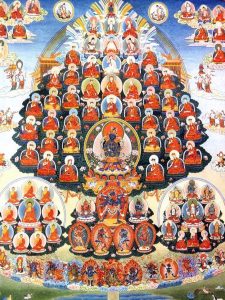
The Lineage of Transmission
Inspiration from Several Traditions
The roots of Ekayana go back to the Tibetan master Lama Gendün Rinpoche who was sent to Europe in 1975 by the 16th Gyalwa Karmapa. Over many years he was the main source of inspiration for Lhundrup and Johann. Gendün Rinpoche embodied the deep wisdom and love of a fully awakened person, and his blessing is still felt in Ekayna. He encouraged Lhundrup to include his previous learning from Vipassana and the Pali texts whenever he was teaching. Furthermore, Gendün constantly pointed to the Essence, to the One Way of Loving Awareness (bodhicitta), and thus we consider him to be at the origin of Ekayana, although the term Ekayana (One Way) goes back 2,500 years to the Buddha himself.
Karma Kagyu Lineage

In his 25 years in France, as a part of the Dhagpo Kagyu Mandala, Lhundrup received a thorough training in the Karma Kagyu lineage of Tibetan Buddhism. This lineage goes back to the Indian masters Tilopa (988‑1069) and Naropa (1016–1100) and was brought to Tibet by the translator Marpa (1012–1097). His main disciple was the Tibetan yogin Milarepa (1042–1123), who became famous through his deep renunciation, his unrelenting devotion and many songs of realisation. His sun-like disciple was the great Mahamudra master Gampopa (1079–1153) from the region of Dhagpo.
His introductory manual of Buddhist practice, the “Juwel Ornament of Liberation” was translated on the request of Lama Gendun Rinpoche by Lhundrup into German, which created an additional strong connection with this lineage. From Gampopa’s disciples, like the first Karmapa and Phamo Drupa, various Kagyu lineages originated in different parts of Tibet. Together they are called “Dhagpo Kagyu”, since their origins are with Gampopa, the “Physician from Dhagpo”. This lineage continued unbroken from the First Karmapa to the Sixteenth Karmapa Rigpe Dorje (1924–1981), who came to Europe and then sent Gendun Rinpoche as his best meditation teacher.
All these great Kagyu masters, together with Machik Labdrön, the woman siddha who founded the school of Chöd (Cutting though), and the great Nyingma masters, are cornerstones of inspiration for the teachings given in Ekayana.
The embodiment of all this wisdom and love coming through these lineages was Gendun Rinpoche who lived and taught in France until 1997. In his early years he travelled widely and became the root lama of many Western disciples, and among them also Lhundrup who practiced eleven years under his close guidance. Johann connected to him in later years through the power of devotion. Since Gendün Rinpoche is the most important teacher for both of us, we include a short biography here. If you wish to know more, have a look at the more extensive biography in his book “Heart Advice of a Mahamudra Master”.
Lama Gendün Rinpoche (1918–1997)

Gendun Rinpoche was born in 1918 in a high valley of the province Nangchen in Kham, East Tibet. His father was a sculptor who engraved mantras in wood and stone. In the summer months the family lived in a large tent with their flocks. The small boy loved to build a hut from branches and played to live like a hermit. Early on he had the ability to think deeply and he wondered about the usefulness of worldly actions at the time of death. He thoroughly thought about the suffering of beings in the different realms and felt deep compassion for their misery. He feared, his parents might suffer the same fate at the time of their death. His father tried to teach to him his profession, but all efforts were in vain.
The boy asked again and again to be allowed to study with a spiritual master. Thus at the age of seven he received the permission to go to the nearby monastery of Khyodrag. The small monk felt really satisfied only when he could practice meditation. Most of the time he spend at the feet of the great masters of his monastery. At the age of 17 he received full ordination and at the age of 21 he began the traditional group retreat of three years and three months.
Afterwards Gendun Rinpoche practiced another seven years in strict seclusion in a monks cell. Eventually his master Tulku Tenzin visited him and told him not to remain any longer in seclusion, because he had attained realization in the practice and had become a true “holder of blessings”. From now on he should go to the people and work for their well-being, because his realization was “irrefutable like a golden rock”.
After some hesitation Rinpoche ended the formal retreat and went on a one-year pilgrimage to holy places throughout Tibet. After that he continued his practice for about ten years in secluded caves that had been blessed by great realized beings of the past. There he attained perfect realization.
In 1959, when Tibet was under military occupation, a protecting deity appeared to Gendun Rinpoche and told him to leave for India. Having faith in the Three Jewels (Buddha, Dharma and Sangha) he and his two companions managed in a most amazing way to cross the lines of the Chinese soldiers and reach India. Having barely arrived, the 16th Karmapa entrusted him with the direction of a new monastery at Bhutan for three years. Afterwards Rinpoche lead a secluded life in Kalimpong (North Bengal) for 12 years and annually received transmissions from the Gyalwa Karmapa.
On his request he came to France in 1975. Since that time he dedicated himself tireless to the spreading of the Dharma. In the years until 1990 he travelled several times through almost all countries of Western Europe. In 1984 he established a retreat centre in Auvergne (France), as well as a monastery and a nunnery, where he mainly taught, up until his death in 1997. This is the place where he passed on the knowledge and experience of the Tibetan Karma Kagyu transmission to Western students in cycles of traditional meditative 3 ½ year retreat.